![[EAI Issue Briefing] South Koreans’ Perceptions of Blocs between ROK-US-Japan and DPRK-China-Russia and Support for Nuclear Armament: 2025 EAI Public Opinion Poll on East Asia](/data/bbs/eng_issuebriefing/20250627104730777206122.png)
[EAI Issue Briefing] South Koreans’ Perceptions of Blocs between ROK-US-Japan and DPRK-China-Russia and Support for Nuclear Armament: 2025 EAI Public Opinion Poll on East Asia
| | 2025-06-27
Yang Gyu KIMㆍInhwan OH
Professor Yang Gyu Kim of Korea National Defense University and EAI Senior Research Fellow Inhwan Oh analyze the correlation between public perceptions of blocs between ROK-US-Japan and DPRK-China-Russia and South Koreans` support for nuclear armament, drawing on the results of the 2025 EAI Public Opinion Poll on East Asia. Kim and Oh find that perceptions of growing U.S.-China rivalry have a significant impact on South Koreans` support for nuclear armament, which reached a new high this year. Based on their analysis, the authors suggest that the Lee administration should use more sophisticated policy language to explain the U.S.-China rivalry, which is unfolding in a different form than the Cold War, and be careful not to further provoke public support for nuclear armament.
I. South Koreans’ all-time high support for nuclear armament amidst President Lee Jae-myung’s inauguration
On June 4, 2025, President Lee Jae-myung was elected the new President with the highest number of votes count in history and a final vote share of 49.42%. With the Democratic Party of Korea securing a majority of 171 seats in the National Assembly, a so-called "supermajority" that controls both the legislative and executive branches was formed (Yonhap News 2025a; Yonhap News 2025b). Backed by a strong momentum for governance, the Lee Jae-myung administration took proactive measures to improve inter-Korean relations from the outset. Notably, South Korea halted its loudspeaker broadcasts toward North Korea, and the North responded positively by stopping its noise broadcasts toward the South (Yonhap News 2025c; Yonhap News 2025d). These developments may serve as an opportunity to raise public expectations for improved inter-Korean relations. Because these optimistic expectations can also affect perceptions of North Korean nuclear threat, the beginning of the Lee Jae-myung administration was expected to mark an important shift in South Korea’s support for nuclear armament. For example, during the inter-Korean rapprochement following the 2018 Pyeongchang Olympics, support for nuclear armament among South Koreans dropped to 43.3%. It was the first and only time since 2013—when the East Asia Institute (EAI) began polling on foreign policy—that opposition (50.3%) exceeded support.
Figure 1. Opinion on South Korea's Nuclear Armament (2016 – 2025)
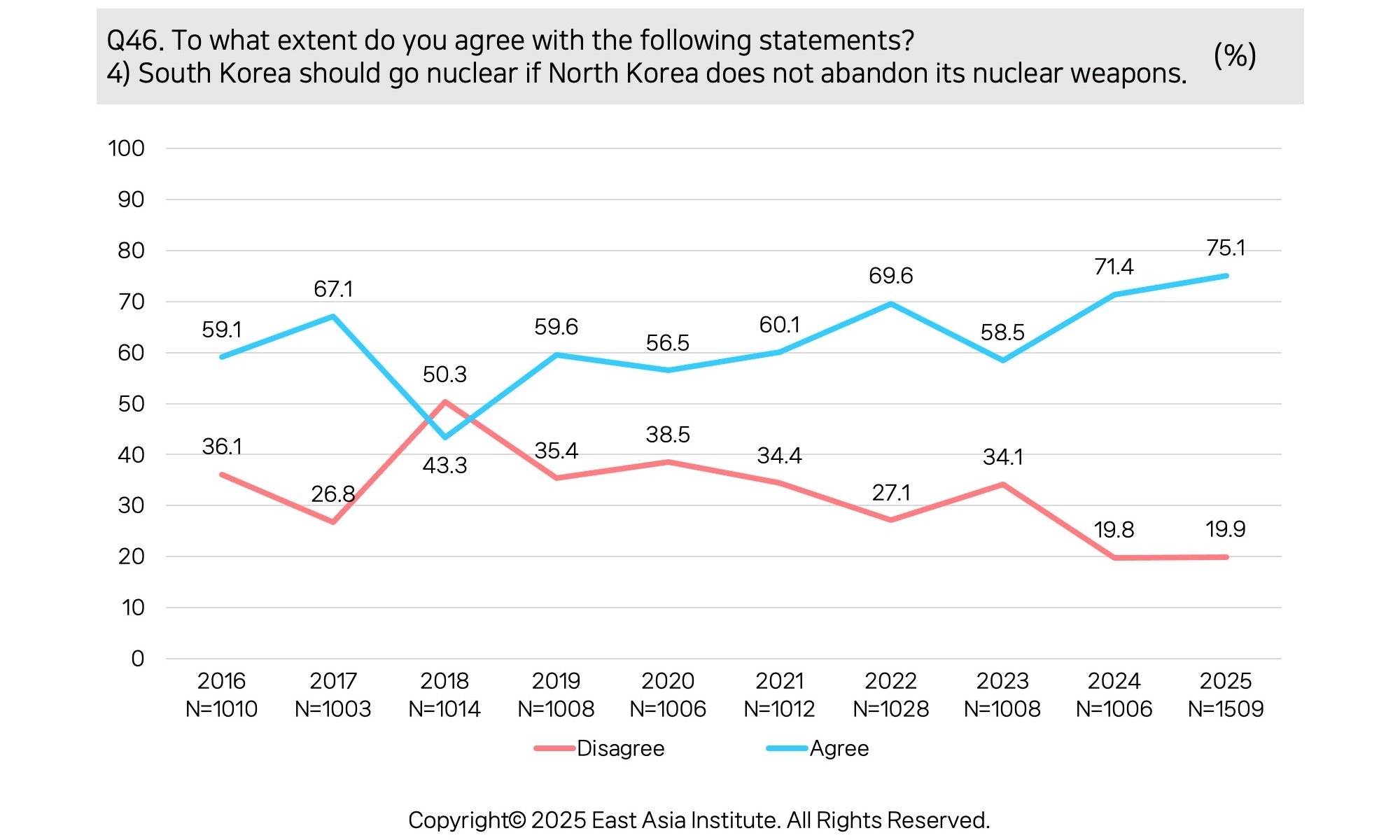
However, contrary to these expectations, a public opinion survey jointly conducted in 2025 by the EAI and Hankook Research showed that South Korean support for nuclear armament surpassed the 2024 level and reached its highest point since 2016. As shown in [Figure 1] and [Figure 2], when asked “If North Korea does not give up on its nuclear weapons, South Korea should develop its own,” 75.1% of respondents either generally agreed or strongly agreed with the statement. This marks a 3.7% increase from the previous year’s 71.4%. Looking more closely, the percentage of those who "generally agree" rose only slightly from 34.8% to 34.9%, a mere 0.1% increase. In contrast, the percentage of those who "strongly agree" increased significantly from 36.6% to 40.2%, an increase of 3.6%. This indicates that the core base of strong support for South Korea’s independent nuclear arsenal is becoming increasingly solidified.
What are the causes behind this record-high level of public support for nuclear armament? How is this support corelated to the ongoing U.S.-China rivalry and the perceptions between the South Korea-U.S.-Japan and the North Korea-China-Russia blocs? This issue briefing aims to analyze emerging trends revealed in the 2025 EAI public poll, showing that the factors influencing support for nuclear armament identified in previous years continue to hold, while perceptions of intensified bloc formation amid the U.S.-China rivalry are becoming more prominent. It additionally seeks to examine the correlation between the two. Compared to last year, the perceived threat from North Korea has increased, and negative perceptions of President Trump have become more pronounced. At the same time, trust in the U.S. extended deterrence has declined. In this context, the rise in support for nuclear armament can be interpreted as reflecting both the current deterioration of inter-Korean relations and growing unease about the reliability of the extended deterrence the United States is supposed to provide. However, at the same time, most respondents also expressed hope that inter-Korean relations would improve under the new administration, indicating the complex and equivocal attitudes South Koreans hold toward the North Korea issue.
Figure 2. Degree of Agreement with South Korea’s nuclear armament (2024-2025)
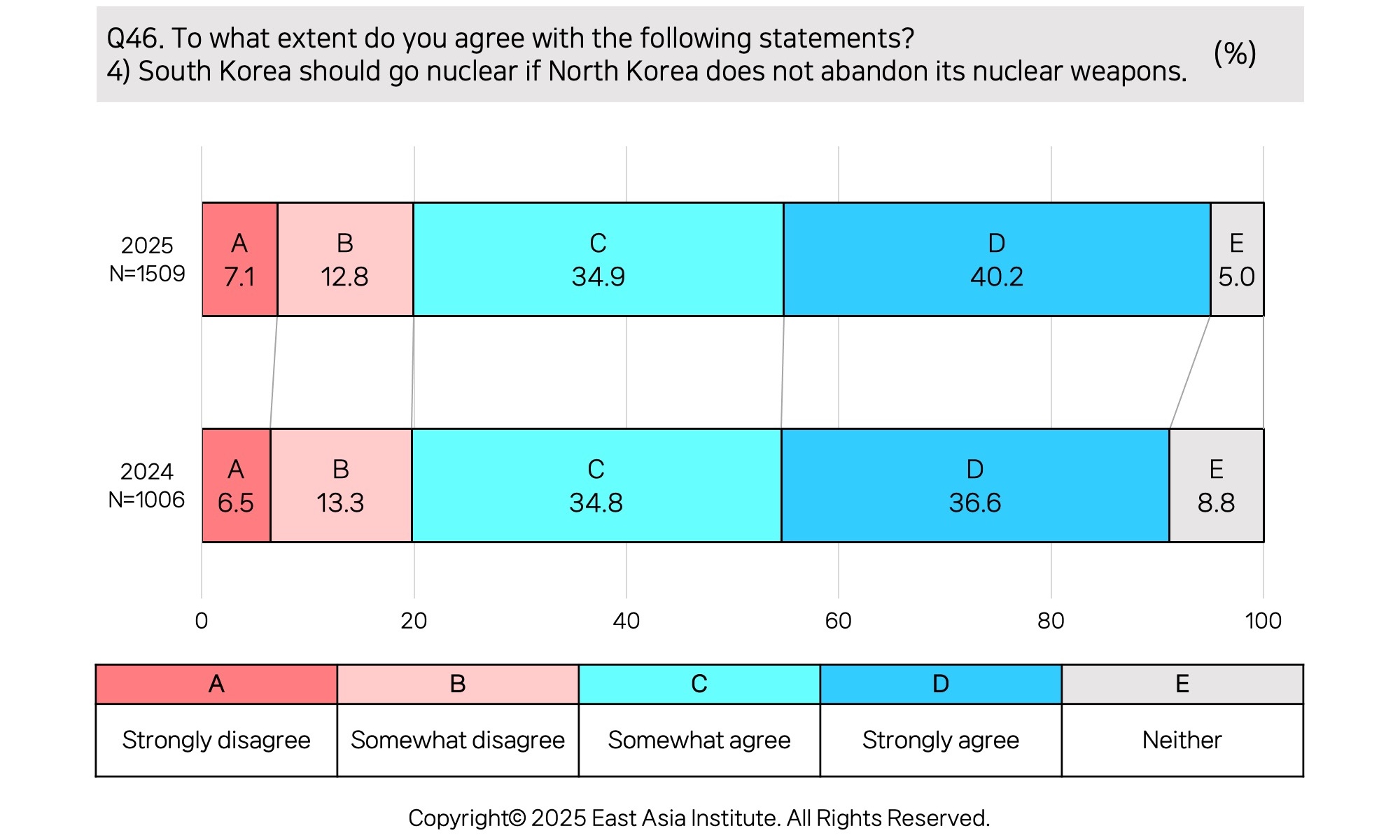
II. Key Characteristics of the 2025 Survey Results: Perceptions of Inter-Korean Relations, the Intensification of U.S.-China Rivalry, and the North Korea-Russia Ties
The rise in support for nuclear armament this year does not necessarily reflect more negative public views of current inter-Korean relations or lower expectations for their future. Despite North Korea’s declaration of the 'Two Hostile States' doctrine in December 2023—a major low point in inter-Korean relations—this year’s assessments of both current ties and the outlook for the next ten years have slightly improved compared to 2024. As shown in [Figure 3], the percentage of respondents who described current inter-Korean relations as "very bad" or "somewhat bad" decreased by 6.9%, from 83.2% last year to 76.3% this year. Meanwhile, the combined percentage of those who answered "neutral" or "somewhat good" increased by 6.9%, from 16.5% to 23.4%. The proportion of people who expect inter-Korean tensions to be aggravated also declined slightly, from 15.8% to 13.4%, while those expecting improved relations rose by 8.7%, from 22.5% to 31.2% ([Figure 4]). Notably, optimism about inter-Korean relations was highest among progressives (47.2%), whereas only 19.6% of conservatives shared this view.
Figure 3. Current Inter-Korea Relations (2024-2025)
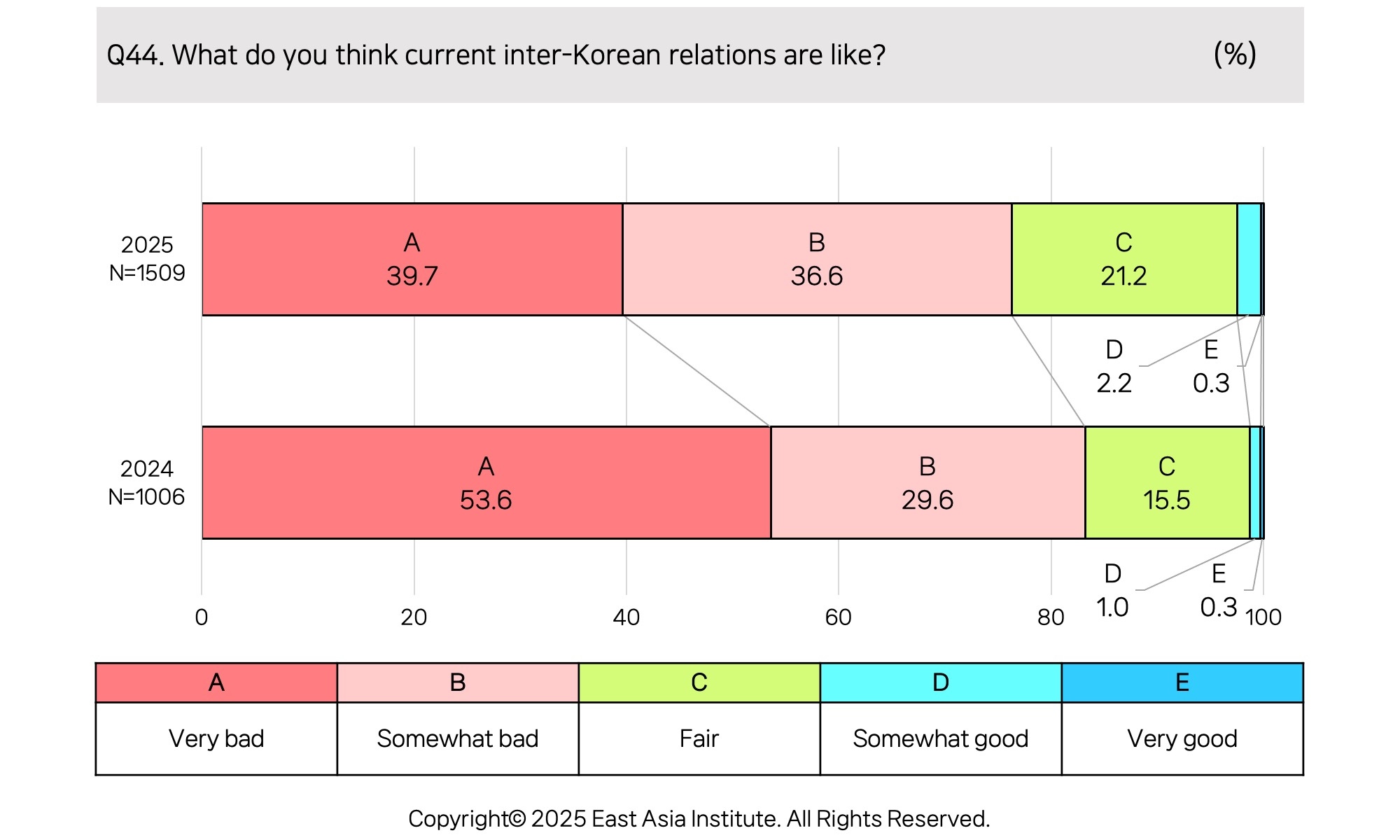
Figure 4. Future of Inter-Korea Relations in 10 Years
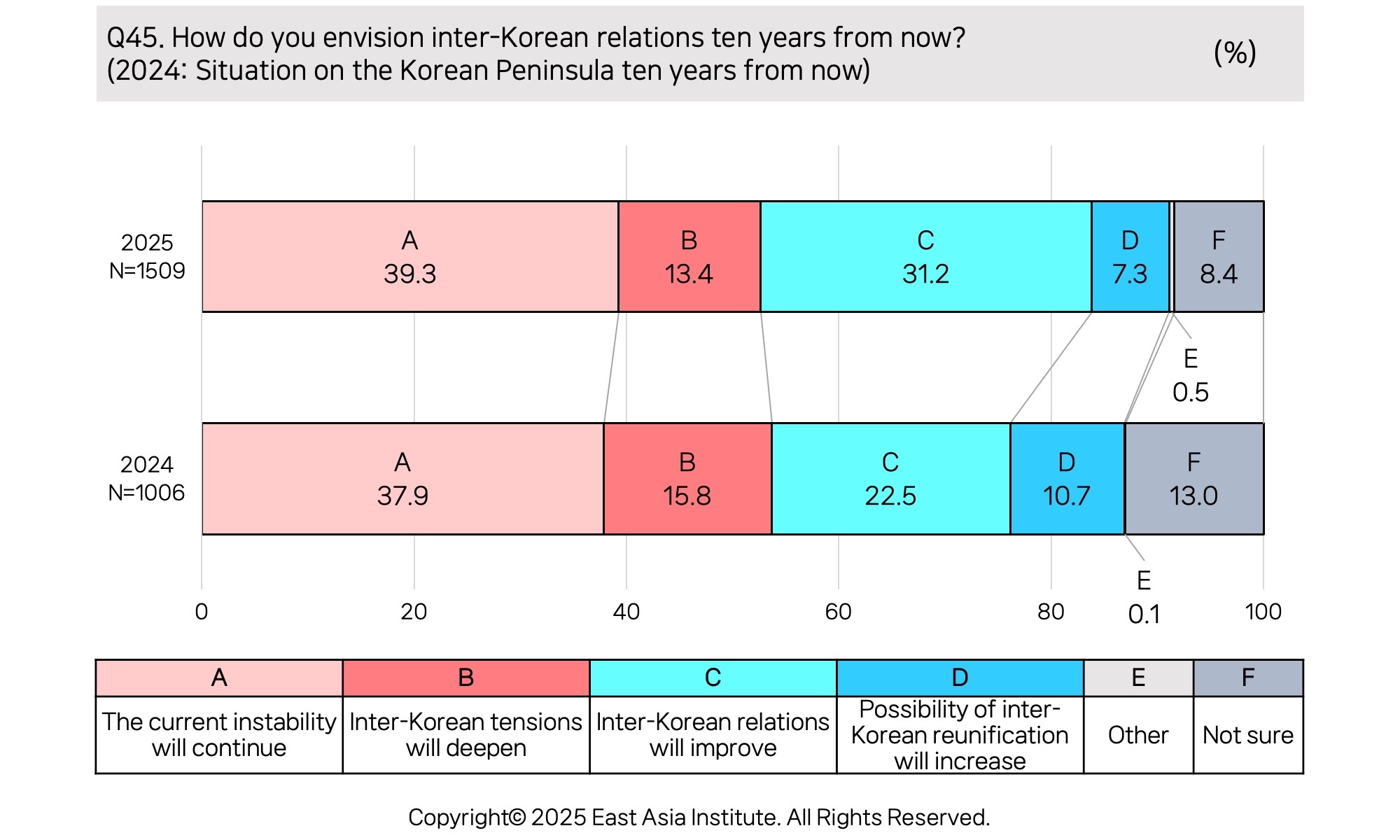
Therefore, it can be inferred that public evaluations of inter-Korean relations or future outlooks alone are not strongly correlated with the rise in South Korean support for nuclear armament. What, then, is driving this record-high support in 2025? Clues can be found in the new patterns observed in this year’s responses regarding the greatest perceived threats facing South Korea and the country’s most important foreign relations. As clearly shown in [Figure 5], the proportion of respondents identifying North Korea’s nuclear and missile threats as the greatest threat to South Korea steadily increased from 2021 to reach a peak of 56.3% in 2023, but then began to decline, falling to 33.2% in 2025, returning to levels similar to those in 2021. In contrast, the percentage of respondents who identified U.S.-China rivalry and conflict as South Korea’s greatest threat has been on the rise since 2023, reaching 64.9% in 2025, the highest in the past five years. [Figure 6] also shows that the proportion of respondents who viewed South Korea–U.S. relations as the country’s most important foreign relationship hit an all-time high of 90.7% this year. Meanwhile, the proportions selecting inter-Korean relations and South Korea–China relations as the most important were similar, at 42.2% and 43.2% respectively.
Figure 5. The Biggest Threats Facing South Korea
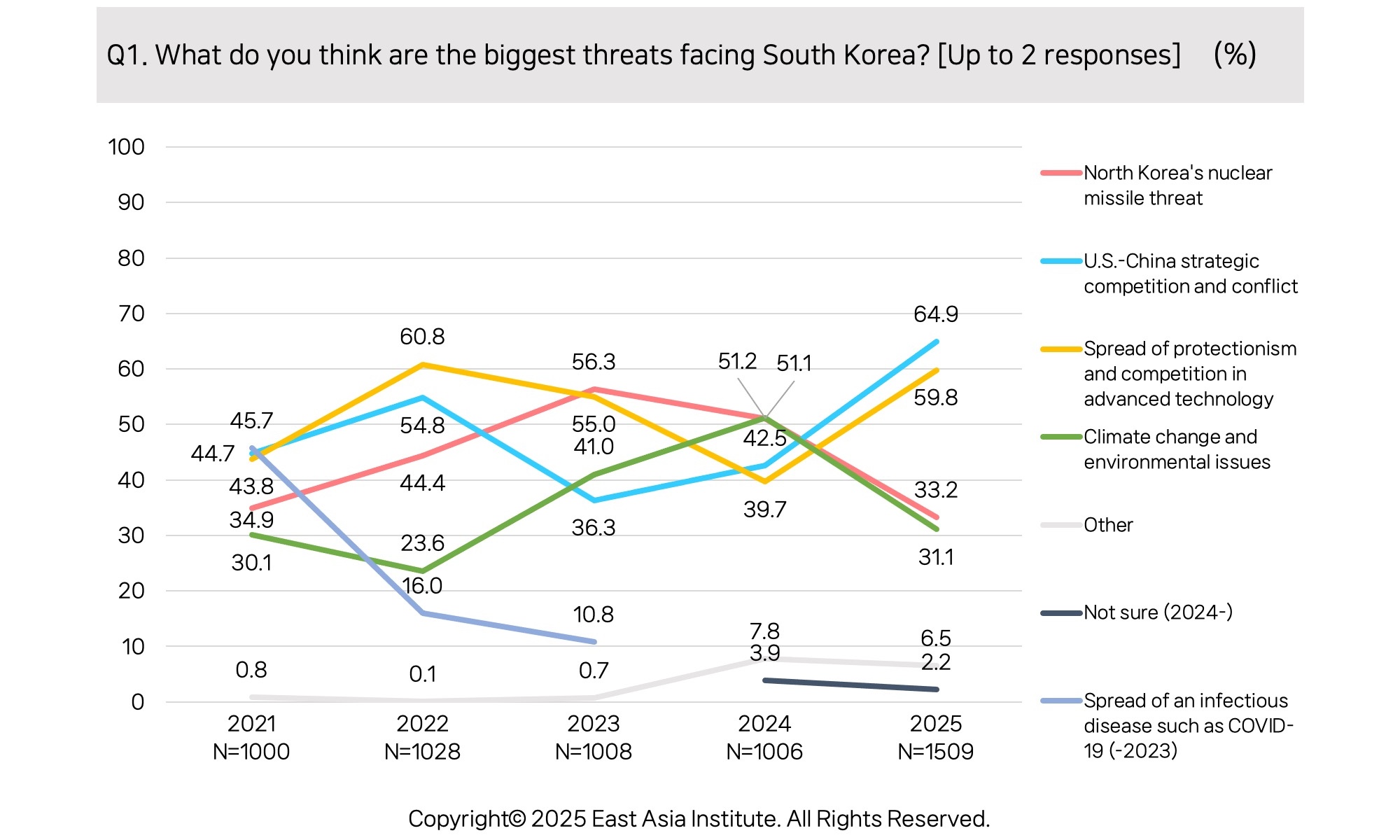
Figure 6. Korea’s Most Important Diplomatic Relations
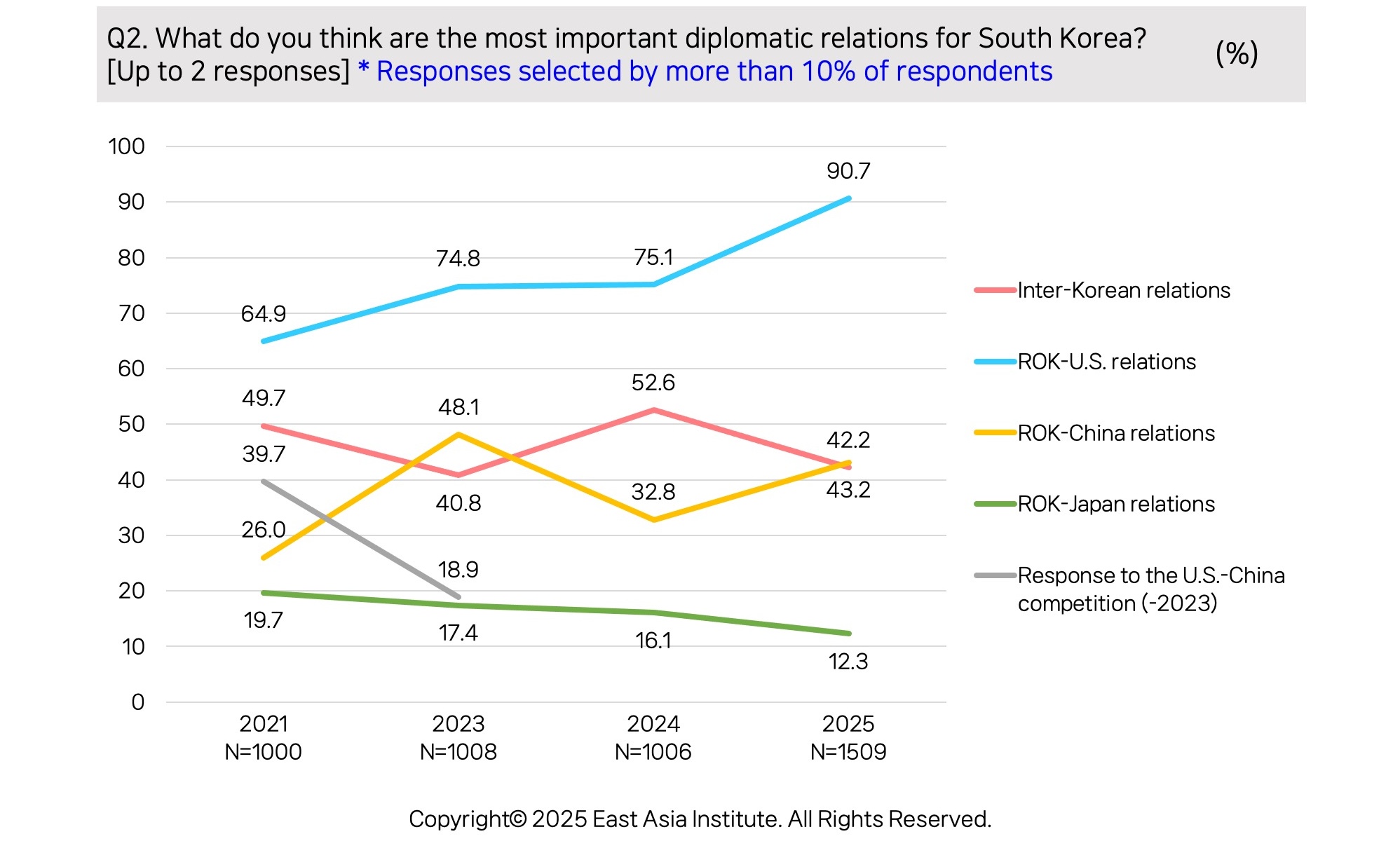
In sum, regardless of whether it was the first Trump administration, the Biden administration, or the second Trump administration, the emerging clarity of U.S.-China rivalry, combined with North Korea’s growing alignment with Russia following the outbreak of the war in Ukraine, appears to be related to the rise in support for South Korea’s nuclear armament. In light of such trends, this briefing examines, through regression analysis, whether the factors emphasized in existing research - such as threat perception, alliance-related variables, political ideology and partisanship, and age - continue to affect support for nuclear armament. At the same time, it explores whether the recent surge in support for nuclear armament is significantly correlated with the increasingly salient perception of bloc formation, namely the U.S.–South Korea–Japan bloc versus the North Korea–China–Russia bloc.
III. Regression Analysis: South Korean Public Support for Nuclear Armament in 2025 and Perceptions of U.S.–South Korea–Japan vs. North Korea–China–Russia Blocs
This year’s EAI Public Opinion Poll on East Asia was conducted as a web-based poll with a panel of 1,509 respondents, proportionally allocated by region, gender, and age based on demographic data as of late April 2025. The survey was administered over two days, June 4 and 5, immediately following the presidential election. A detailed overview of the survey is presented in [Table 1]. Regarding South Koreans’ perceptions of bloc formation amid the U.S.–China rivalry, a new question was added to the existing item that asked about support for strengthened trilateral security cooperation among South Korea, the U.S., and Japan. The new question asked respondents what alignment orientation they believe North Korea will pursue about China and Russia. The results of the regression reaffirmed the influence of key variables identified in the 2024 EAI Issue Briefing analysis (Kim, 2024). In addition, there was a statistically significant positive correlation between support for nuclear armament and both support for South Korea–U.S.–Japan security cooperation and the expectation that North Korea will increasingly align with Russia and China.
Table 1. 2025 EAI Perceptions on East Asia Survey
|
|
2025 EAI Perceptions on East Asia Survey |
|
Population |
Nationwide adults aged over18 |
|
Sampling Frame |
Hankook Research Politics and Society Panel |
|
(approximately 70 thousand people) |
|
|
Sampling Method |
Proportional selection by region, gender, and age (as of April 2025) |
|
Sample Size |
1509 |
|
Sample Error |
Assuming random sampling, the maximum allowable sampling error at the 95% confidence level is ±2.5%p. |
|
Survey Method |
Web Survey |
|
Response Rate |
22.5% (among 6,701 people who requested, with 1,006 people completed the survey) |
|
Survey Duration |
2025.6.4.~2025.6.5. |
|
Research Organization |
Hankook Research Co. Ltd |
|
Sample Demographic |
[Gender] |
|
[Age] |
1. Drivers of South Korean Support for Nuclear Armament: North Korean Nuclear Threat, Trust in Extended Deterrence, and Perceptions of Bloc Formation
Existing literature on the credibility of extended deterrence and nuclear proliferation has identified several key drivers of public support for nuclear armament: perceptions of security threats, the credibility of security guarantees offered by allies, the international status and prestige associated with possessing nuclear weapons, and the influence of domestic actors advocating for nuclear armament (Sagan 1996–1997; Singh and Way 2004; Jo and Gartzke 2007; Solingen 2007; Kroenig 2009; Bleek 2010). Analysis of the 2024 EAI East Asia Survey confirmed that (1) threat perceptions regarding North Korea's nuclear weapons, (2) disbelief about the credibility of U.S. extended deterrence, and (3) conservative political orientations were all significant factors influencing public preferences for nuclear arming (Kim, 2024). Based on this year’s public poll, an ordinal logistic regression analysis was conducted to examine not only the continued influence of these factors, but also whether perceptions of bloc formation, specifically the U.S.–South Korea–Japan bloc versus the North Korea–China–Russia bloc, show a statistically significant impact on support for nuclear armament. As noted earlier, support for South Korea’s nuclear armament was measured on a 5-point scale, and the results of the statistical analysis are presented in [Table 2].
Table 2. Factors Influencing South Korea's Support for Independent Nuclear Arming
|
Dependent Variable |
Model 1: Security Threats |
Model 2: Security Threats, Perception of Inter-Korea Relations |
Model 3: Security Threats, Perception of Inter-Korea Relations, Perception of Block Formation |
Model 4: Security Threats, Perception of Inter-Korea Relations, Perception of Block Formation, Party Support |
Model 5: All |
|
Belief that DRPK may launch a preemptive strike |
0.572*** |
0.561*** |
0.492*** |
0.477*** |
0.489*** |
|
Belief in the U.S. Extended Deterrence |
-0.281*** |
-0.271*** |
-0.257*** |
-0.263*** |
-0.273*** |
|
Evaluation of Current Inter-Korea Relations |
|
-0.0992 |
-0.108 |
-0.0739 |
-0.0260 |
|
Evaluation of Future Inter-Korea Relations |
|
-0.0872 |
-0.0453 |
-0.0160 |
-0.0212 |
|
Support for the ROK-U.S.-Japan Trilateral Cooperation |
|
|
0.421*** |
0.352*** |
0.323*** |
|
View of DPRK Strengthening China-Russia Ties |
|
|
0.353*** |
0.328** |
0.290** |
|
Support for Democratic Party |
|
|
|
0.00858 |
0.0386 |
|
Support for People Power Party |
|
|
|
0.760*** |
0.442* |
|
No Party Support |
|
|
|
0.0669 |
-0.0278 |
|
Generation |
|
|
|
|
0.140*** |
|
Political Ideology (Progressive→Conservative) |
|
|
|
|
0.0919** |
|
Gender |
|
|
|
|
-0.0448 |
|
Cut 1 |
-1.678*** |
-2.194*** |
-0.593 |
-0.599 |
0.136 |
|
Cut 2 |
-0.375* |
-0.891** |
0.767* |
0.766 |
1.508*** |
|
Cut 3 |
-0.0710 |
-0.587 |
1.084** |
1.086** |
1.832*** |
|
Cut 4 |
1.635*** |
1.123*** |
2.879*** |
2.909*** |
3.687*** |
|
Observations |
1509 |
1509 |
1509 |
1509 |
1509 |
* p<0.05, ** p<0.01, *** p<0.001; T-values are reported in parentheses.
As expected, perceptions of the threat posed by North Korea and beliefs about the credibility of U.S. extended deterrence were found to have statistically significant effects on support for nuclear armament (Models 1–5). Specifically, the more respondents believed that a North Korean preemptive strike is likely, and the more they believed that U.S. extended deterrence is insufficient to counter the North Korean nuclear threat, the more likely they were to support South Korea possessing its own independent nuclear deterrent. Evaluations of current inter-Korean relations and expectations for future inter-Korean relations, on the other hand, did not show a statistically significant correlation with support for nuclear armament.
In this analysis, particular attention was given to perceptions of bloc formation, which were measured through respondents’ support for South Korea–U.S.–Japan security cooperation and their views on what kind of alignment approach North Korea is likely to adopt toward China and Russia. Both variables were consistently found to be statistically significant (Models 3–5). This indicates that (1) those who support trilateral security cooperation among South Korea, the U.S., and Japan, and (2) those who believe North Korea is strengthening its ties with both Russia and China, effectively aligning itself with the China–Russia bloc, are more likely to support South Korea’s nuclear armament. Support for a particular political party, age group, and political ideology were also confirmed to be significant factors (Models 4–5). Support for nuclear armament is significantly more common among People Power Party (PPP) supporters, older generations, and individuals with conservative political orientations.
2. Support for Trilateral Security Cooperation among South Korea, the U.S., and Japan
What motivates people to support trilateral security cooperation among South Korea, the U.S., and Japan? To explore answers to this question, the authors have set the support for trilateral security cooperation as the dependent variable. Also, a U.S.–China conflict perception model is added to the existing regression models by including independent variables such as: (1) whether respondents selected military support measures (ranging from ammunition support to troop deployment) in response to a potential conflict in the Taiwan Strait, and (2) whether respondents identified U.S.–China conflict as the greatest threat to South Korea’s security ([Table 3]).
Table 3. Factors Supporting Trilateral Security Cooperation
|
Variable |
Model 1 |
Model 2 |
Model 3 |
Model 4 |
Model 5 |
|
Belief that DRPK may launch a preemptive strike |
0.375*** |
|
0.345*** |
0.280*** |
0.268*** |
|
Threat Perception toward DPRK |
0.619*** |
|
0.719*** |
0.422** |
0.356* |
|
Belief that ROK should engage militarily in a Taiwan contingency |
|
0.926*** |
0.791*** |
0.688*** |
0.635*** |
|
Threat Perception toward US-China Rivalry |
|
0.054 |
0.293** |
0.245* |
0.220 |
|
Support for the Democratic Party of Korea |
|
|
|
-0.217 |
-0.103 |
|
Support for People Power Party |
|
|
|
1.324*** |
0.993*** |
|
No Party Support |
|
|
|
0.413** |
0.333* |
|
Generation |
|
|
|
|
0.051 |
|
Political Ideology |
|
|
|
|
0.140*** |
|
Gender |
|
|
|
|
-0.162 |
|
cut1 |
-1.770*** |
-2.833*** |
-1.621*** |
-1.737*** |
-1.248*** |
|
cut2 |
-0.136 |
-1.245*** |
0.026 |
-0.057 |
0.433 |
|
cut3 |
0.220 |
-0.904*** |
0.389** |
0.319 |
0.814** |
|
cut4 |
2.647*** |
1.443*** |
2.888*** |
2.989*** |
3.533*** |
|
Observations (N) |
1509 |
1509 |
1509 |
1509 |
1509 |
* p<0.05, ** p<0.01, *** p<0.001; T-values are reported in parentheses.
Across Models 2–5, it was consistently confirmed that those who believe South Korea should provide military support and intervene in the event of a U.S.–China military conflict in the Taiwan Strait is more likely to strongly support trilateral security cooperation among South Korea, the U.S., and Japan. While respondents who identified U.S.–China conflict as the greatest threat to South Korea’s security also tended to support strengthening trilateral security cooperation (Models 3–4), the statistical significance of this relationship disappeared in models that included additional control variables.
In addition, those who perceive North Korea as a threat, support the PPP, non-partisan respondents, and those who lean more conservative are more likely to support for trilateral security cooperation among South Korea, the U.S., and Japan. These variables were also included as controls in the previous regression models. The fact that they have statistically significant effects in both regression analyses suggests the possibility of multicollinearity issues. To address this issue, a separate linear regression model was conducted using the independent variables from the analysis, and the Variance Inflation Factor (VIF) was examined. The results showed that the VIF values for all variables were below 2.29, well below the commonly problematic threshold range of 5 to 10, indicating that multicollinearity is not a concern in this study.
To conclude, those who perceive North Korea’s nuclear weapons as the greatest threat or believe that South Korea should provide military support and intervene in the event of a U.S.–China conflict in the Taiwan Strait are more likely to support trilateral military cooperation among South Korea, the U.S., and Japan. This suggests that South Koreans with stronger threat perceptions of North Korea’s nuclear capabilities or stronger bloc formation awareness centered on U.S.–China rivalry and the Taiwan crisis are more likely to endorse trilateral security cooperation.
3. Perceptions of North Korea’s Pursuit of a New Cold War Strategy
Another dimension of how Koreans perceive blocs is the perception of North Korea’s alignment orientation vis-à-vis China and Russia. Since the collapse of the Hanoi Summit in 2019, North Korea’s recent actions, such as deploying troops to the Russia–Ukraine war and signing a treaty for mutual military support with Russia, are assumed to have had some impact on South Koreans’ perceptions of bloc formation. With this assumption, an additional regression analysis was conducted (see Table 4).
This year, the newly added Question 47 was used to clarify the variables that influenced responses selecting the option that North Korea will closely align itself with both China and Russia. Specifically, those who perceive a high likelihood of a North Korean preemptive strike were more likely to believe that North Korea is pursuing a closer alignment with China and Russia. Similarly, respondents who view North Korea as the greatest security threat facing South Korea also tended to strongly perceive the formation of a North Korea–China–Russia bloc. However, as shown in Models 4 and 5, this statistical significance weakened when additional control variables were included.
Interestingly, the variable measuring support for South Korea's military engagement in the event of a Taiwan contingency, previously found to have a significant positive correlation with support for trilateral security cooperation among South Korea, the U.S., and Japan, shows a statistically significant negative correlation in Models 3 to 5. This suggests that those who believe South Korea should actively intervene militarily in a U.S.–China conflict over Taiwan are less likely to view North Korea as closely aligning with China and Russia to form a strong bloc. While further analysis is needed to fully decipher this relationship, one possible interpretation is that individuals who strongly support the U.S.–ROK alliance or trilateral military cooperation with the U.S. and Japan may perceive the North Korea–China–Russia bloc as unstable or unsustainable. Meanwhile, other independent variables, such as support for the PPP and age, show a statistically significant positive correlation with the perception of a North Korea–China–Russia bloc. In contrast, support for the Democratic Party of Korea (DPRK) shows a significant positive correlation with the perception of a closer ties among North Korea, China, and Russia only in Model 4, but not in models that include additional control variables.
IV. Conclusion and Policy Implications
The analysis of the 2025 EAI Public Poll on East Asia as seen above provides new evidence that the record-high support for nuclear armament among South Koreans this year was significantly shaped by growing perceptions of bloc formation between South Korea–U.S.–Japan and North Korea–China–Russia amid ongoing U.S.–China rivalry. While expectations of improved inter-Korean relations under the new government are especially evident among the politically and ideologically progressive respondents, the challenging security realities and perceptions of blocs driven by the U.S.-China rivalry have led to a higher level of support for nuclear armament among PPP supporters, the elderly, and conservatives than last year. Notably, the analysis also found a rising tendency to support nuclear armament even among respondents who do not support any party.
These results suggest that, given the already high level of public support for nuclear armament, the rise of a new Cold War or bloc-based discourse may further reinforce public preference for going nuclear. The current competition between South Korea–U.S.–Japan and North Korea–China–Russia unfolds in a significantly different way from the great power rivalry of the Cold War era. The United States no longer assumes the role of the leader of the liberal international order, instead adopting a more transactional approach even toward its allies. Within the North Korea–China–Russia alignment, the country leading the way is not Russia, but China. Moreover, the U.S.–China rivalry is not clearly a contest for absolute hegemony that either side can firmly secure, nor can it be easily reduced to a purely ideological confrontation.
Therefore, the Lee Jae-myung administration needs to use more sophisticated policy language to refer to the 21st-century U.S.–China rivalry, which is unfolding in a quite different manner than the Cold War, so as to not further provoke domestic support for nuclear armament. As confirmed, the perception of intensified U.S.–China competition tends to correlate with stronger support for trilateral security cooperation among South Korea, the U.S., and Japan, as well as for military engagement by South Korea in the event of a Taiwan Strait contingency. However, it is important to note that such correlated factors do not necessarily translate into a perception of a stronger North Korea–China–Russia cooperation or bloc formation. Perhaps, South Koreans are already recognizing the complex security dynamics of East Asia: One that cannot be captured by a simplistic term like “South Korea–U.S.–Japan vs. North Korea–China–Russia” or “new Cold War.”■
References
Bleek, Philipp C. 2010. “Why Do States Proliferate? Quantitative Analysis of the Exploration, Pursuit, and Acquisition of Nuclear Weapons.” In Forecasting Nuclear Proliferation in the 21st Century, Volume 1: The Role of Theory, ed. William C. Potter and Gaukhar Mukhatzhanova. Stanford: Stanford University Press.
Jo, Dong-Joon, and Erik Gartzke. 2007. “Determinants of Nuclear Weapons Proliferation.” Journal of Conflict Resolution 51, 2: 167–194.
Ko, Dongwook. 2025. “President Lee orders military to stop broadcasting loudspeakers in North Korea as of 2 p.m.” Yonhap News. June 11. https://www.yna.co.kr/view/AKR20250611150500001?section=news (Accessed June 17, 2025)
Kim, Hojun. 2025. “Joint Chiefs of Staff: “No North-South noise broadcast today” ... North Korea responds by stopping loudspeakers.” Yonhap News. June 12, https://www.yna.co.kr/view/AKR20250611150500001?section=news (Accessed June 17, 2025)
Kim, Yang Gyu. 2024. “Analyzing South Koreans’ Support for Nuclear Arms in 2024: Has the Washington Declaration’s Reassuring Effect Faded?” EAI Issue Briefing. October 22. https://eai.or.kr/new/ko/pub/view.asp?intSeq=22669&board=kor_issuebriefing (Accessed June 17, 2025)
Kroenig, Matthew. 2009. “Importing the Bomb: Sensitive Nuclear Assistance and Nuclear Proliferation.” Journal of Conflict Resolution 53, 2: 161–180.
Lee, Yumi. 2025. “President Lee wins 17.28 million votes, record ‘most votes ever,” Yonhap News. June 4. https://www.yna.co.kr/view/AKR20250604019551001 (Accessed June 17, 2025)
Sagan, Scott D. 1996-1997. “Why Do States Build Nuclear Weapons? Three Models in Search of a Bomb.” International Security 21, 3 (Winter): 54-86.
Singh, Sonali, and Christopher R. Way. 2004. “The Correlates of Nuclear Proliferation: A Quantitative Test.” Journal of Conflict Resolution 48, 6: 859-885.
Solingen, Etel. 2007. Nuclear Logics: Contrasting Paths in East Asia and the Middle East, Princeton: Princeton University Press.
Yim, Hyungseop. 2025. “Lee Jae-myung elected 21st president...’martial law reckoning’ comes three years after regime change.” Yonhap News.June 4. https://www.yna.co.kr/view/AKR20250603035000001 (Accessed June 17, 2025)
■ Yang Gyu KIM is Assistant Professor at Korea National Defense University.
■ Inhwan OH is Senior Research Fellow at the East Asia Institute.
■ Translated and edited by Inhwan OH, EAI Senior Research Fellow; Kyoungnak MINN, Intern
For Inquiries: 02-2277-1683 (ext. 202) ihoh@eai.or.kr
Center for Japan Studies
![[EAI Issue Briefing] The Public Prioritizes a Future-oriented Cooperation over Resolving the History Problem in Korea-Japan Relations: 2025 EAI Public Opinion Poll on East Asia](/data/bbs/eng_issuebriefing/20250627164526777359170(0).jpg)
[EAI Issue Briefing] The Public Prioritizes a Future-oriented Cooperation over Resolving the History Problem in Korea-Japan Relations: 2025 EAI Public Opinion Poll on East Asia
Yul Sohn | 2025-06-27
![[EAI Public Opinion Briefing] 2025 EAI Public Opinion Poll on the 21st Presidential Election](/data/bbs/eng_issuebriefing/20250624151044137155354(0).png)
[EAI Public Opinion Briefing] 2025 EAI Public Opinion Poll on the 21st Presidential Election
East Asia Institute | 2025-06-27